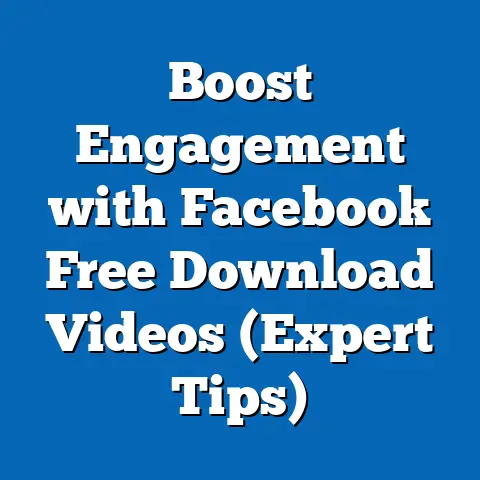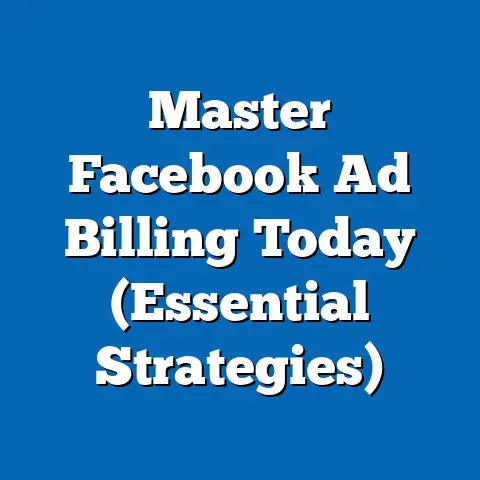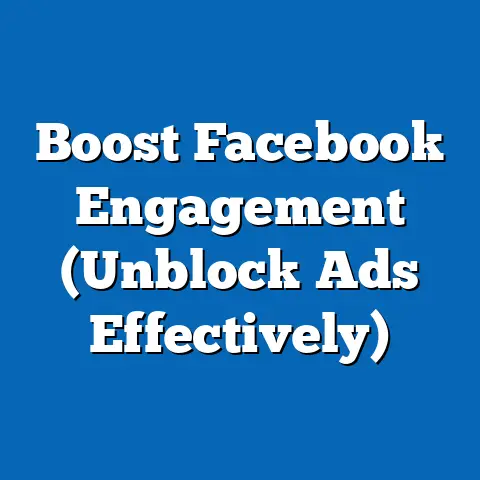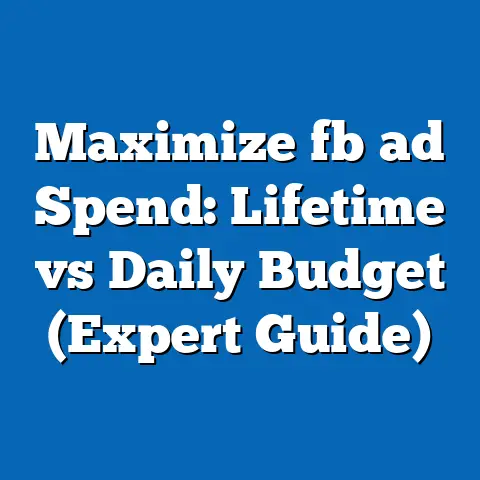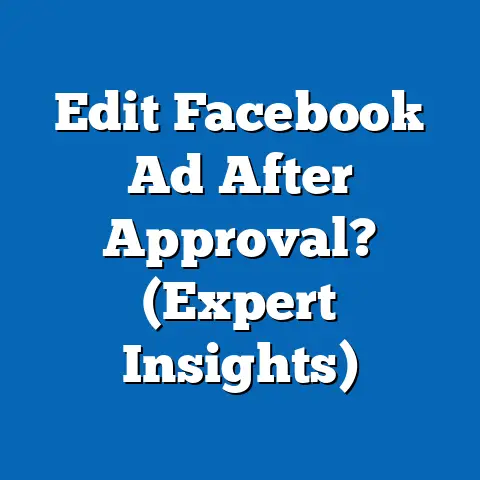Master Facebook Ads Page (Proven Strategies Revealed)
Facebook advertising has become an indispensable tool for businesses aiming to thrive in today’s competitive digital landscape. From startups to established enterprises, everyone is leveraging the power of Facebook Ads to boost brand awareness, engage their target audience, and drive conversions. I’ve seen firsthand how a well-crafted Facebook ad campaign can transform a struggling business into a thriving one.
But here’s the catch: Facebook Ads is constantly evolving. Over the years, I’ve witnessed numerous changes and upgrades to the platform. Think about the introduction of new ad formats like Reels Ads, improved targeting options leveraging AI, and advanced analytics tools that provide deeper insights into campaign performance. Staying up-to-date with these changes is crucial for maximizing your return on investment (ROI).
This guide is designed to help you navigate the complexities of Facebook Ads and master the art of creating high-performing campaigns. I’ll share proven strategies, based on my own experiences and industry best practices, that will empower you to optimize your ad spend and achieve your business goals. Let’s dive in!
Understanding Facebook Ads
At its core, Facebook Ads is a paid advertising platform that allows businesses to display ads to Facebook users based on their demographics, interests, behaviors, and connections. It’s a powerful tool that goes beyond traditional marketing, offering precise targeting and measurable results.
What are Facebook Ads?
Facebook Ads are advertisements created and managed through Facebook’s advertising platform. These ads appear in various placements, including the Facebook News Feed, Instagram Feed, Messenger, and Audience Network.
Think of it as renting billboard space on the most popular social media platform in the world. But unlike a static billboard, Facebook Ads can be tailored to reach specific individuals, making your message highly relevant.
Types of Facebook Ads
Facebook offers a variety of ad formats to suit different marketing objectives. Here are some of the most common types:
- Image Ads: Simple yet effective, image ads consist of a single image with accompanying text. They are ideal for showcasing products or services with a clear visual.
- Video Ads: Engaging and dynamic, video ads capture attention and convey complex messages in a short amount of time. I’ve found that short, attention-grabbing videos tend to perform best.
- Carousel Ads: This format allows you to display multiple images or videos in a single ad, each with its own headline, description, and link. It’s perfect for showcasing a range of products or telling a story.
- Collection Ads: Designed for e-commerce businesses, collection ads feature a catalog of products that users can browse directly within the ad.
- Instant Experience Ads (formerly Canvas Ads): These full-screen, mobile-optimized ads offer an immersive experience for users. They can include videos, images, carousels, and interactive elements.
- Lead Generation Ads: These ads are designed to collect leads directly within Facebook, without requiring users to visit an external landing page.
- Reels Ads: Short-form video ads that appear within Facebook Reels and Instagram Reels. These are fantastic for capturing attention and showcasing your brand in a fun, engaging way.
Setting Clear Objectives
Before you start creating ads, it’s crucial to define your campaign objectives. What do you want to achieve with your Facebook Ads? Common objectives include:
- Brand Awareness: Increase visibility and recognition of your brand.
- Reach: Show your ad to the maximum number of people within your target audience.
- Traffic: Drive traffic to your website or landing page.
- Engagement: Encourage users to like, comment, and share your content.
- Lead Generation: Collect leads for your sales team.
- Conversions: Drive sales or other desired actions on your website.
- App Installs: Encourage users to download your mobile app.
Choosing the right objective is essential because it tells Facebook’s algorithm what you want to achieve, which influences how your ads are delivered and optimized.
Key Takeaway: Understanding the different types of Facebook Ads and setting clear objectives are the foundational steps to creating successful campaigns.
Targeting Your Audience
One of the most powerful features of Facebook Ads is its ability to target specific audiences with laser-like precision. This ensures that your ads are seen by the people who are most likely to be interested in your products or services.
The Significance of Audience Targeting
Imagine showing an ad for vegan protein powder to a group of meat-loving bodybuilders. It’s unlikely to be effective, right? That’s why audience targeting is so crucial. It allows you to focus your ad spend on the people who are most likely to convert.
Targeting Options Available
Facebook offers a wide range of targeting options, including:
- Demographic Targeting: Target users based on age, gender, location, education, relationship status, and other demographic factors.
- Interest-Based Targeting: Reach users based on their interests, hobbies, and pages they’ve liked on Facebook.
- Behavior Targeting: Target users based on their online behavior, such as purchase history, device usage, and travel habits.
- Custom Audiences: Create custom audiences based on your existing customer data, such as email lists, website visitors, or app users.
- Lookalike Audiences: Expand your reach by creating lookalike audiences based on your existing customer data. These audiences consist of people who share similar characteristics with your best customers.
Creating Lookalike Audiences
Lookalike audiences are one of my favorite targeting strategies. They allow you to tap into new potential customers who are likely to be interested in your products or services.
To create a lookalike audience, you need a source audience, such as a customer list or website visitor data. Facebook then analyzes the characteristics of your source audience and identifies other users who share similar traits.
The key to a successful lookalike audience is a high-quality source audience. The more data you provide to Facebook, the better it can identify the right people.
Data Analytics and Refining Target Demographics
Data analytics plays a crucial role in refining your target demographics. By tracking the performance of your ads, you can identify which demographics are most responsive to your messaging.
For example, you might discover that your ads are performing particularly well among women aged 25-34 who are interested in fitness. You can then refine your targeting to focus on this specific demographic.
Key Takeaway: Effective audience targeting is the key to reaching the right people with your Facebook Ads. By leveraging the various targeting options available and continuously refining your demographics based on data analytics, you can maximize the effectiveness of your campaigns.
Crafting Compelling Ad Content
Once you’ve identified your target audience, the next step is to create compelling ad content that captures their attention and drives action. A successful Facebook ad consists of three key elements: visuals, copy, and call-to-action (CTA).
The Key Elements of a Successful Facebook Ad
- Visuals: The visual element of your ad is the first thing people see, so it needs to be eye-catching and relevant to your message.
- Copy: Your ad copy should be persuasive and concise, highlighting the benefits of your product or service and addressing the needs of your target audience.
- Call-to-Action (CTA): Your CTA should clearly tell people what you want them to do, whether it’s visiting your website, making a purchase, or signing up for a newsletter.
Creating Visually Appealing Ads
To create visually appealing ads that stand out in users’ feeds, consider the following tips:
- Use high-quality images and videos: Avoid blurry or pixelated visuals.
- Choose visuals that are relevant to your target audience: Consider their interests and preferences.
- Use bright colors and bold designs: Capture attention and make your ad stand out.
- Use visuals that tell a story: Connect with your audience on an emotional level.
- Consider using user-generated content (UGC): Show real people using your products or services.
Writing Persuasive Ad Copy
Your ad copy should be persuasive and concise, highlighting the benefits of your product or service and addressing the needs of your target audience. Here are some tips for writing effective ad copy:
- Know your audience: Understand their pain points, desires, and motivations.
- Highlight the benefits, not just the features: Explain how your product or service will improve their lives.
- Use strong verbs and action words: Encourage people to take action.
- Keep it concise: Get to the point quickly and avoid jargon.
- Use social proof: Include testimonials, reviews, or statistics to build trust.
Examples of High-Performing Ads
Let’s take a look at some examples of high-performing Facebook Ads and analyze what makes them effective:
- Example 1: A clothing brand using a visually appealing image of a model wearing their clothes. The image is high-quality, the model is relatable, and the ad copy highlights the comfort and style of the clothing. The CTA is “Shop Now.”
- Example 2: A software company using a video ad to demonstrate the benefits of their product. The video is engaging, the software is easy to use, and the ad copy emphasizes the time-saving and productivity-boosting features. The CTA is “Learn More.”
- Example 3: A local restaurant using a carousel ad to showcase their menu items. Each image is mouth-watering, the descriptions are enticing, and the ad copy highlights the restaurant’s ambiance and customer service. The CTA is “Order Now.”
Key Takeaway: Crafting compelling ad content is essential for capturing attention and driving action. By using high-quality visuals, persuasive ad copy, and clear CTAs, you can create ads that resonate with your target audience and achieve your marketing objectives.
Budgeting and Bidding Strategies
One of the most crucial aspects of Facebook advertising is setting a budget and choosing the right bidding strategy. This determines how much you’re willing to spend on your ads and how Facebook will optimize your campaigns.
Budgeting Options Available
Facebook offers two main budgeting options:
- Daily Budget: Set a fixed amount that you’re willing to spend on your ads each day.
- Lifetime Budget: Set a total amount that you’re willing to spend on your ads over the entire duration of the campaign.
The best option for you depends on your goals and how much control you want over your ad spend. I often recommend starting with a daily budget to test different ad variations and targeting options before committing to a larger lifetime budget.
Bidding Strategies
Facebook offers several bidding strategies to choose from, each designed to achieve different campaign goals:
- Cost-Per-Click (CPC): You pay each time someone clicks on your ad. This is a good option if you want to drive traffic to your website.
- Cost-Per-Impression (CPM): You pay for every 1,000 impressions your ad receives. This is a good option if you want to increase brand awareness.
- Cost-Per-Conversion: You pay each time someone takes a desired action, such as making a purchase or signing up for a newsletter. This is a good option if you want to drive conversions.
- Lowest Cost: Facebook automatically bids on your behalf to get you the lowest possible cost per result. This is a good option if you’re new to Facebook advertising or if you want to let Facebook optimize your campaigns.
- Target Cost: You set a target cost per result, and Facebook tries to get you results at or below that cost. This is a good option if you have a specific cost target in mind.
Monitoring Ad Performance and Adjusting Budgets and Bids
It’s crucial to monitor the performance of your ads and adjust your budgets and bids accordingly for optimal results. Here are some tips for monitoring and adjusting your campaigns:
- Track key performance metrics (KPIs): Monitor metrics such as click-through rates (CTR), conversion rates, and return on ad spend (ROAS).
- Analyze your data: Identify which ads, targeting options, and bidding strategies are performing best.
- Adjust your budgets and bids: Increase your budgets for high-performing ads and decrease your budgets for low-performing ads. Adjust your bids to optimize for your desired results.
- A/B test different ad variations: Test different headlines, images, and CTAs to see what resonates best with your audience.
- Stay up-to-date with Facebook’s algorithm: Facebook’s algorithm is constantly evolving, so it’s important to stay informed about the latest changes and adjust your strategies accordingly.
Key Takeaway: Budgeting and bidding strategies are crucial for maximizing your ROI on Facebook Ads. By choosing the right budgeting option, selecting the appropriate bidding strategy, and continuously monitoring and adjusting your campaigns, you can optimize your ad spend and achieve your marketing objectives.
Analyzing and Optimizing Campaigns
Data analysis is the backbone of successful Facebook advertising. Without tracking and analyzing your campaign performance, you’re essentially flying blind.
The Importance of Data Analysis
Data analysis allows you to understand what’s working and what’s not. It provides insights into your audience, your ad creative, and your bidding strategies. This information is essential for optimizing your campaigns and maximizing your ROI.
Using Facebook Ads Manager to Track KPIs
Facebook Ads Manager is your central hub for tracking key performance metrics (KPIs). Some of the most important KPIs to track include:
- Click-Through Rate (CTR): The percentage of people who click on your ad after seeing it. A high CTR indicates that your ad is relevant and engaging.
- Conversion Rate: The percentage of people who take a desired action, such as making a purchase or signing up for a newsletter, after clicking on your ad. A high conversion rate indicates that your landing page is effective and your offer is compelling.
- Cost Per Click (CPC): The average cost you pay each time someone clicks on your ad. A low CPC indicates that your ads are efficient and your targeting is effective.
- Cost Per Acquisition (CPA): The average cost you pay for each conversion. A low CPA indicates that your campaigns are profitable and your marketing efforts are paying off.
- Return on Ad Spend (ROAS): The amount of revenue you generate for every dollar you spend on advertising. A high ROAS indicates that your campaigns are highly profitable.
A/B Testing Ad Variations
A/B testing, also known as split testing, is a powerful technique for identifying the most effective elements of your ads. It involves creating two or more variations of your ad and testing them against each other to see which performs best.
You can A/B test different headlines, images, ad copy, CTAs, and targeting options. The goal is to identify the winning combination that drives the best results.
Ongoing Optimization
Optimization is an ongoing process that involves continuously adjusting your targeting, creative, and bidding strategies based on performance data. It’s not a one-time task, but rather a continuous cycle of testing, analyzing, and refining.
Here are some tips for ongoing optimization:
- Regularly review your data: Set aside time each week to analyze your campaign performance.
- Identify areas for improvement: Look for ads, targeting options, or bidding strategies that are underperforming.
- Experiment with new ideas: Don’t be afraid to try new things and test different approaches.
- Stay up-to-date with Facebook’s algorithm: Facebook’s algorithm is constantly evolving, so it’s important to stay informed about the latest changes and adjust your strategies accordingly.
Key Takeaway: Analyzing and optimizing your Facebook Ads campaigns is essential for maximizing your ROI. By tracking key performance metrics, A/B testing ad variations, and continuously refining your strategies, you can achieve your marketing objectives and drive business growth.
Conclusion
Mastering Facebook Ads is an ongoing journey that requires continuous learning, adaptation, and a willingness to experiment. By understanding the fundamentals of the platform, targeting the right audience, crafting compelling ad content, setting appropriate budgets, and analyzing your campaign performance, you can unlock the full potential of Facebook advertising and achieve your business goals.
Remember, Facebook Ads is constantly evolving, so it’s important to stay up-to-date with the latest features, best practices, and industry trends. Embrace the challenge, stay curious, and never stop learning.
Call to Action
Now it’s your turn! Share your experiences with Facebook Ads in the comments section below. What strategies have worked best for you? What challenges have you faced? And don’t forget to subscribe for more insights on digital marketing strategies.

